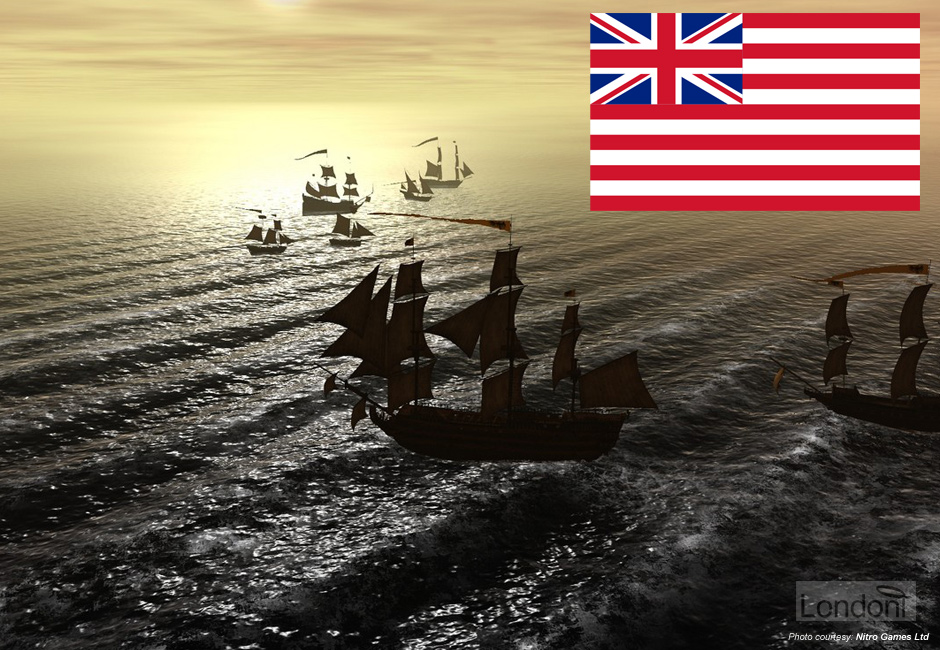
Background to (British) East India Company - the world's first multinational
Rise of English maritime
Initially the English were afraid to challenge the naval supremacy of the Portuguese and Spanish. However, after the successful sea voyages of English navigators round the world in 1580 and the defeat of the 'invincible' Spanish Armada (1588) gave them new found courage to undertake trading voyages to the east.
Their target was the affluent spice trade of the East Indies (present day Indonesia).
Joint stock company
In 1599, a group of merchants, known as the Merchant Adventurers, formed a commercial organisation called the 'Company of Merchants of London Trading into the East Indies' for that purpose. Subsequently they became the infamous East India Company.
It was a joint stock company whereby 200 or 218 merchants, mainly rich and prominent individuals from all over Europe, pooled their resources and shared the risk and profit because it was considered a dangerous trade with high cost. During those days, naval voyages from Britain to East Indies could take 12-18 months, therefore a return voyage (including procurement of goods) could last anything between 3-4 years. As such the journeys required a high level of capitalisation to cover the cost of the large infrastructure (e.g. big, powerful ships and large, skilled labour force) and investors did not get quick return on their funding. It was therefore financially necessary to float the company as a joint stock company, allowing the investors to share the burden and potential huge profit of such a venture.
The Company was led by one Governor and 24 directors, who made up the Court of Directors. They, in turn, reported to the Court of Proprietors (i.e. the 200 merchants), which appointed them. The owners ploughed money into the company whilst the directors were left to manage the company – this separation of role is similar to modern day multinational corporation, as such the East India Company is considered the first of the world’s multinational.
Royal Charter gives monopoly
On a freezing New Year’s Eve (31 December) in 1600, Elizabeth I, the Queen of England, granted the Company monopoly of trade in the east for 15 years by a Royal Charter (a formal document issued by a monarch granting a right or power to an individual or a corporation).
However, it was not unusal to receive Royal Charters during that period. Beyond the prestigious that’s associated with having such royal approval, it also offered protection and royal aide should anything go wrong. There were many other European 'East India Company' that were formed during the 17th century - Dutch (1602), Danish (1616), Portuguese (1628), French (1664) and Swedish (1731) - all of which received royal charters with similar monopoly of trade. But the English East India Company was the first and oldest amongst these corporations whilst their arch-rival, the Dutch, was the largest.
The Company’s main commercial strategy was monopoly. Its royal charter gave it exclusive control over trade with the East. This enabled the Company to manipulate the prices paid by British consumers for its goods. Every 20 years, pressure would mount for opening the trade to other merchants and cities in England, but the Company was skilled at rewarding its supporters at Court and in Parliament, and these bids were successfully rebuffed until the early 19th century.
For at least two millennia, from Roman times, Europe had always been Asia’s commercial supplicant, shipping out gold and silver in return for spices, textiles and luxury goods. And for the first 150 years after its establishment by Queen Elizabeth I in 1600, the Company had to repeat this practice, as there was simply nothing that England could export that the East wanted to buy.
 Elizabeth I ()
Elizabeth I ()  Dutch East India Company ()
Dutch East India Company ()  Portuguese East India Company ()
Portuguese East India Company () 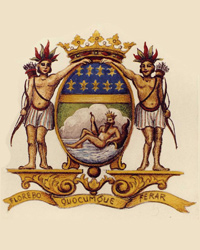 French East India Company ()
French East India Company ()
Limited liability
One of the benefits the Company derived from its relations with the state was limited liability. Before the rise of state-backed companies, businesses had imposed unlimited liability on their investors. If things went wrong, creditors could come after them for everything they possessed, down to their cufflinks, and have them imprisoned if they failed to pay. Some firms had already been granted limited liability, and the Company’s officers persuaded Queen Elizabeth that it should be given this handy status too.
The East India Company foreshadowed the modern world in all sorts of striking ways. It was one of the first companies to offer limited liability to its shareholders. It laid the foundations of the British empire. It spawned Company Man. And—particularly relevant at the moment—it was the first state-backed company to make its mark on the world.
Strong back-up
A second benefit of state backing was monopoly. In the 17th century, round-the-world voyages were rather like space missions today. They involved huge upfront costs and huge risks. Monopoly provided at least a modicum of security. The third benefit was military might. The Company’s Dutch and Portuguese competitors could all call on the power of their respective navies. The English needed to do likewise in order to unlock investors’ purses.
Still, getting into bed with the government was risky for the Company. It meant getting close to courtiers who wanted to extract revenue from it and exposing itself to politicians who wanted to rewrite its charter. The Whig revolutionaries who deposed James II in 1688 briefly promoted a competing outfit that the Company first fought and eventually absorbed. Rival merchants lobbied courtiers to undermine its monopoly. But for the most part it dealt with these political problems brilliantly. Indeed its most valuable skill—its "core competence" in the phrase beloved of management theorists—was less its ability to arrange long-distance voyages to India and beyond than its ability to manage the politicians back home.
The Company created a powerful East India lobby in Parliament, a caucus of MPs who had either directly or indirectly profited from its business and who constituted, in Edmund Burke's opinion, one of the most united and formidable forces in British politics. It also made regular gifts to the Court: "All who could help or hurt at Court," wrote Lord Macaulay, "ministers, mistresses, priests, were kept in good humour by presents of shawls and silks, birds’ nests and attar of roses, bulses of diamonds and bags of guineas". It also made timely gifts to the Treasury whenever the state faced bankruptcy. In short, it acted as what George Dempster, a stockholder, called a "great money engine of state".
At its peak, its influence stretched from western India to eastern China via the farthest reaches of the Indonesian archipelago. It funded governments, toppled princes and generated spectacular amounts of money from trading textiles, drugs and spices. But this wasn’t an empire, it wasn’t even a state, it was a company. The East India Company, founded in 1600, lasted for 258 years before the British state gained full control of its activities. In that time it had redrawn the map of India, built an empire and reinvented the fashions and the foodstuffs of Britain.
Failure to gain the Indonesian market brings the English to India
When the East India Company was founded, England was a marginal island kingdom competing for survival against both the Catholic empires of Portugal, France and Spain, and the commercial power of Holland. The four small ships that set sail from London in 1601 were desperate to find an English niche in this lucrative trade.
The Company’s primary target was the spice trade of the East Indies. Initially, the voyages to the East reaped huge returns: cloves sold from the Company's third voyage made profits of 234%. However, the Dutch and Portuguese were already established in the Spice Islands of the East Indies, therefore they turned their attention to India.
What lives on from these times are tales of piracy and high adventure. Pirates have an ambiguous place in English folklore, part feared and part celebrated, and the first wave of East India traders simply continued an old English tradition: trade where necessary and plunder where possible. Though sometimes favoured by local people in the East Indies in their battles against the Dutch, the motive was always the same: to secure exclusive control of local spice production. But the Company progressively lost the “spice race”, outgunned and outclassed by the Dutch. Driven from the Moluccas following the massacre of English traders at Amboyna in 1623, the Company eventually exchanged its remaining outpost in the East Indies at Run for New Amsterdam in 1667 – quickly renamed New York.
The Company’s attraction to India stemmed from their cotton and silk textile trade. India was the world leader in producing cotton and silk at that time and the English East India Company imported these goods to Britain which developed a massive appetite for clothing.
The import of cotton and silk allowed the British to have regular clean underwear for the first time ever.
But since Britain wasn’t producing anything they had to pay for the textiles by exporting silver and bullion from the country.
British "beggers to feast" in an advanced Indian civilisation
During the 16th century the Muslim empires of Ottoman and Mughals, and the Spanish empire were the dominant forces around the world. When the Europeans arrived in Mughal India they encountered a civilisation that was far advanced on many levels. The economy, the culture, the military and the administration were far superior to what they were accustomed to, therefore in order or them to establish themselves within India and move inward from the 'fringes' they had to liaise with prominent Indians. These Indians offered language skills, expertise and capital and as such the early years of the Europeans became an ‘age of partnership’.
The British in particular inter-married, adopted new customs, and learnt Urdu and Persian (spoken widely, especially by the Mughal officials) since they were "beggers to feast", and they quickly developed "alliances of necessity". Initially, there were no sense of superiority amongst the British, in fact, they were inferior to the Muslim and Hindu Bengalis, and they were more focused on trade, not conquest.
The English Crown doesn’t tend to take a leading role with anything approaching an empire or adventourous overseas commerce, it privatises these sort of things, so it relies on its merchants to do this.
Linda Colley, Professor of History at the London School of Economics
Establish base in India
The Company’s ships arriving in India would dock at Surat, Gujrat, which was established as a trading transit point in 1608. The following year King James I, who took over the reign of England on 24 March 1603 after Queen Elizabeth I had passed away, renewed the Royal Charter given to the Company for an indefinite period, including a clause which specified that the charter would cease to be in force if the trade turned unprofitable for three consecutive years.
Within 15 years of its incorporation the king of England recognised "the extra-ordinary benefit" its trade brought to England. The continuance of the these extraordinary benefits, the Company’s supporters argued, depended largely on favourable privileges from the native rulers abroad, and from the English crown at home. From the former it sought the most favourable trading treatment possible, and from the latter a monopoly of English trade to the East Indies. In practice, however, the Company enjoyed neither the most favourable trading treatment abroad nor an English monopoly at home.
Also in 1609, Captain Hawkins went to the court of Mughal Emperor Jahangir on behalf of the East India Company and appealed to him for permission to establish a factory. Initially, due to opposition by the Portuguese, who were already established in India, and the local merchants of Surat, Emperor Jahangir refused. However, after the naval victory of the English Captain Thomas Best over the Portuguese in 1612, the Emperor changed his mind and permitted the English to establish a factory in 1613 at Surat.
With the arrival of English ambassador Sir Thomas Roe, who was sent by King James I to the Mughal court in 1615, the Company quickly established further factories at Agra (Delhi), Ahmedabad (Gujrat) and Broach () – to add to their factory in the town of Masulipatam on the Coromandel Coast, their first factory in India established in 1611. The Mughal were initially happy to allow the British to trade ir order to provide the arrogant Portuguese with competition, and prevent conversion to Catholicism which the British promised they wouldn’t do.
The first English settlement near the Gangetic estuary was Pippli in Orissa, at which the East India Company was permitted to trade in 1634, five years before the foundation of Madras (now Chennai). The river on which Pippli stood has since silted up, and the very site of the English settlement is now a matter of conjecture. In 1640, a factory was opened in Hughli; in 1642, at Balasor; and in 1681, Bengal was erected into a separate presidency, though still subordinate to Madras.
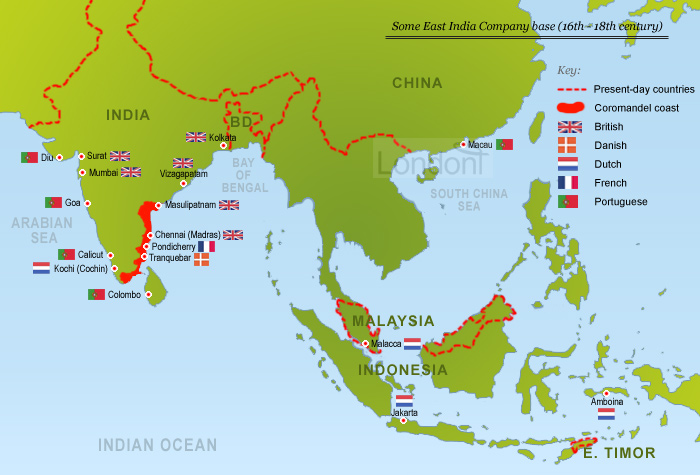
Source: Marxist blog
English and Portuguese relationship also improved dramatically during the 17th century, especially after the marriage of English King Charles II to Portuguese princess Catherine of Braganza in 1661. Seven years later, in 1668, a cash-strapped King Charles II transferred Mumbai (then Bombay), which he had received as part of the dowry from the king of Portugal, to the East India Company in return for a sizeable loan and an annual rent of £10. Mumbai soon superseded Surat and became the Company’s headquarters in western India, whilst Madras became the headquarters for the whole of eastern India.
The latter half of the 17th century saw rapid expansion of English trade in India. In 1651 the Company opened their factory at Hooghly, and later in Patna, Cassimbazar and Rajmahal.
Duty-free trade
Under the provisions of a farman (imperial charter, almost equivalent to commercial treaty) issued by Emperor Shah Jahan a year earlier, the English traders were exempted from paying inland transit duties on goods bound for the western coast of export. The farman of 1650 did not specifically apply to Bengal. The intention of the farman could not have been to excuse the English from paying export duties at the Bengal ports. However, by a misrepresentation of the farman of 1650, the English traders obtained from Shah Shuja, the Nawab of Bengal, a nishan (letter-patent issued by provincial governors) certifying that the English goods were to be exempt from road and port duties "in accordance with" the farman of 1650. Having established this precedent, the Company, between 1656 and 1672, secured from Shah Shuja and his successors at least six parwanas confirming the nishan of 1651. The only significant change through these years had been the establishment of a yearly tribute of Rs. 3,000 to be paid to the nawab of Bengal for this concession.
Shah Shuja’s successor, Shaista Khan, also exempted the East India Company from payment of duties in 1672.
In the 1670’s the stoppage of the English trade by the local officials had become such a serious abuse that the Company finally decided to approach Mughal emperor Aurangzeb, who had replaced Shah Jahan in 1659, and obtained a farman in 1680 forbidding any molestation of the Company’s people and any obstruction of their trade.
Be it known that... it is agreed of the English nation that besides their usual custom of 2% for their goods, more 1.5% jizya, or poll [tax] money, shall be taken. Wherefore it is commanded, that in the said place [Surat] 3.5% of all their goods, on account of custom or poll money be taken for the future. (And at all other places) upon this account, let no one molest them for custom, (rashdari, peshcash, farmaish)...
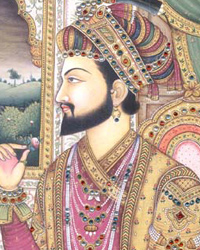 Emperor Shah Jahan ()
Emperor Shah Jahan () 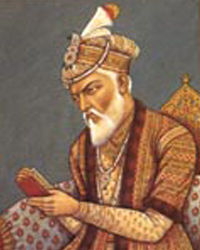 Emperor Aurangzeb ()
Emperor Aurangzeb () 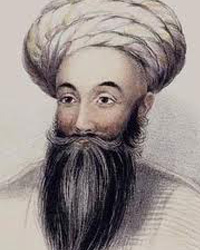 Nawab Shah Shuja ()
Nawab Shah Shuja () 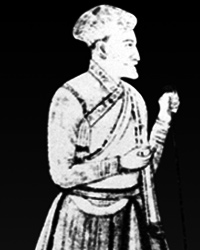 Shaista Khan ()
Shaista Khan ()
